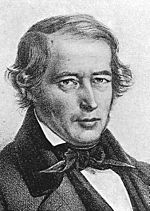Jakob Steiner facts for kids
Quick facts for kids
Jakob Steiner
|
|
|---|---|
 |
|
| Born | 18 March 1796 |
| Died | 1 April 1863 (aged 67) |
| Citizenship | Swiss |
| Known for | Euclidean geometry Projective geometry Synthetic geometry |
| Scientific career | |
| Fields | Mathematics |
| Influences | Fritz Bützberger |
Jakob Steiner (born March 18, 1796 – died April 1, 1863) was a Swiss mathematician. He mostly worked on geometry. He is known as one of the greatest pure geometers.
Contents
Life of Jakob Steiner
Steiner was born in a small village called Utzenstorf in Switzerland. When he was 18, he became a student of Heinrich Pestalozzi. Later, he studied in Heidelberg, Germany.
After his studies, he moved to Berlin. He earned money by tutoring students. In Berlin, he met A. L. Crelle. Crelle was impressed by Steiner's talent. This led Crelle to start his famous Journal in 1826. This journal published important math papers.
In 1832, Steiner published his book Systematische Entwickelungen. Because of his great work, a new professor position was created for him. This was at the University of Berlin in 1834. He held this job until he passed away in 1863.
Steiner's Math Work
Steiner's main focus was geometry. He loved to solve problems using shapes and drawings. This is called synthetic geometry. He did not like using algebra for geometry problems. He thought it was a shame if algebra solved problems better.
Many people thought he was the best pure geometer since Apollonius of Perga. His work was very broad and his proofs were very careful.
Projective Geometry Ideas
In his book Systematische Entwickelung, Steiner helped create modern synthetic geometry. He worked a lot with projective geometry. In this type of geometry, even parallel lines meet. They meet at a special "point at infinity".
This idea means that two points always make a line. Also, two lines always meet at a point. This balance between points and lines is called projective duality.
Steiner also studied how shapes change when you project them. He found special sets of points and lines. These sets stayed the same after projection. He is famous for his way of drawing a conic section. This is a special curve like a circle or an ellipse. It's called the Steiner conic.
Drawing with a Straight Edge and Circle
In another book from 1833, Steiner showed something amazing. He proved that you can solve many geometry problems using only a straight edge. You don't need a compass. The only thing you need is one circle already drawn on the paper. This was a very clever discovery.
Other Discoveries
Steiner also found a formula for how planes divide space. Imagine cutting a cake with knives. His formula tells you the most pieces you can make. He also studied Steiner's chain of tangential circles. These are circles that touch each other in a special way.
He also worked on the isoperimetric theorem. This theorem is about finding the shape that holds the most area for a given boundary. For example, a circle holds the most area for a certain perimeter.
Many of Steiner's other writings are in Crelle's Journal. Some of his most important papers are about algebraic curves and surfaces. These are shapes described by algebraic equations. He wrote a short paper called Allgemeine Eigenschaften algebraischer Curven. It only showed the results, not how he got them. Other mathematicians later figured out his methods.
Steiner also studied maxima and minima problems. These are about finding the biggest or smallest possible values. He solved problems that were very hard, even for advanced math methods at the time.
In 1853, Steiner made a small but important contribution to combinatorics. This is a field of math about counting and arranging things. He wrote about what are now called Steiner systems. These are basic types of block designs.
His earliest papers were published after his death. This was done by his admirer, Fritz Bützberger.
See also
 In Spanish: Jakob Steiner para niños
In Spanish: Jakob Steiner para niños
- Arrangement of lines
- Malfatti circles
- Miquel and Steiner's quadrilateral theorem
- Minkowski–Steiner formula
- Mixed volume
- Power of a point theorem
- Steiner curve
- Steiner symmetrization
- Steiner system
- Steiner surface
- Steiner conic
- Steiner's conic problem
- Steiner's problem
- Steiner tree
- Steiner chain
- Poncelet–Steiner theorem
- Parallel axes rule
- Steiner–Lehmus theorem
- Steiner inellipse
- Steinerian
- Steiner point (computational geometry)
- Steiner point (triangle)

